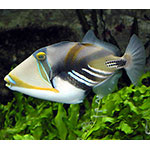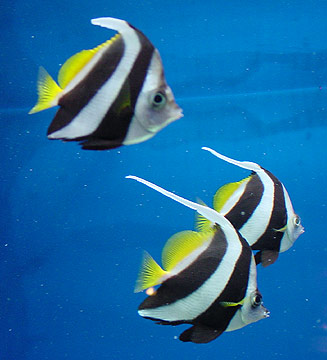Picasso / Humu Humu Triggerfish

|
Scientific Name: Rhinecanthus aculeatus Price: Upon Request Origin: Indo-Pacific Family: Balistidae NOT AVAILABLE NOW |
|
Other Names: Blackbar triggerfish, Picasso Triggerfish, Huma Huma Trigger, Whitebanded Triggerfish, Painted Triggerfish, Lagoon Triggerfish, HumaHuma Picasso Trigger Fish, Huma Picasso, Lagoon Blackbar Triggerfish |
|
Technical Info
Temperature: 22 - 26 ℃
pH: 8.1 - 8.4
GH: 8 - 12
SG: 1.020 - 1.025
Max size: 30 cm
Min Tank size: 440 Ltr
Position in Aqua: Top swimmer
Description
The Picasso / Humu Humu Triggerfish has a wacky, painted appearance. It has a tan body with gradient dark bands, and vibrant blue and black stripes on the top of the head, with a yellow stripe from cheek to cheek and deeply set-back eyes.
Food
The Picasso / Humu Humu Triggerfish should be fed a varied diet. Many, but not all, specimens accept flake food and pellets. A good diet should consist of a variety of different food sources such as different types of chopped up sea food, frozen food, preparations for omnivorous fish, live food and (if your Picasso triggerfish accepts it) flake food. They should be fed little but often. Feed them at least 2-3 times a day.
Breeding
We have no information about anyone successfully breeding Picasso triggerfish in a home aquarium. In the wild, the male Picasso trigger protects a territory with several females in it. Each female protects its own territory within the males' territory. During spawning season the females dig a pit in which they spawn. This behavior makes it likely that a very large aquarium is required to breed Picasso triggerfish. Fry and larvae caught in the wild have proved very hard to raise. Sexing Picasso triggerfish is possible as males are larger than females of the same age. This method is however not very reliable.
Compatible with
Only one Triggerfish per tank. Keep with large basses, groupers, large surgeonfish, aggressive eels, lionfish and puffers. Do not keep with invertebrates.
Note
This is an active fish that always seems to be trying to figure out how to find another meal. It will lift coral rubble and shells as it searches for hidden prey, and may even rest on its side and use its pectoral fin to dig in the sand.

